Abstract
Thirty two children (aged 5-19 years) with no clinical evidence of significant cardiovascular disease undertook continuous staged supine exercise on a bicycle ergometer. Multigated radionuclide ventriculography was performed at rest and during each exercise stage. Exercise duration and total workload both increased with age. Aerobic work correlated better with age than did total work. In most children the ejection fraction for both ventricles increased by at least 5% with exercise. Right ventricular ejection fraction did not decrease with exercise in any subject but left ventricular ejection fraction decreased by 2% and 9% in two. The response of end diastolic volume to exercise was variable, but there was a consistent decrease in mean (SD) end systolic volume of the left (29(22)%) and right (30(19)%) ventricles. Cardiac index (mean (SD)) increased by 234(65)% with exercise. The left ventricular:right ventricular end diastolic volume ratio (mean (SD)) at rest was 1.26(0.26). It is concluded that exercise radionuclide ventriculography is an excellent technique for a combined assessment of exercise capacity and an evaluation of ventricular size and performance in children. These values for supine bicycle exercise in children without significant cardiovascular disease will be useful for future comparisons with other groups.
Full text
PDF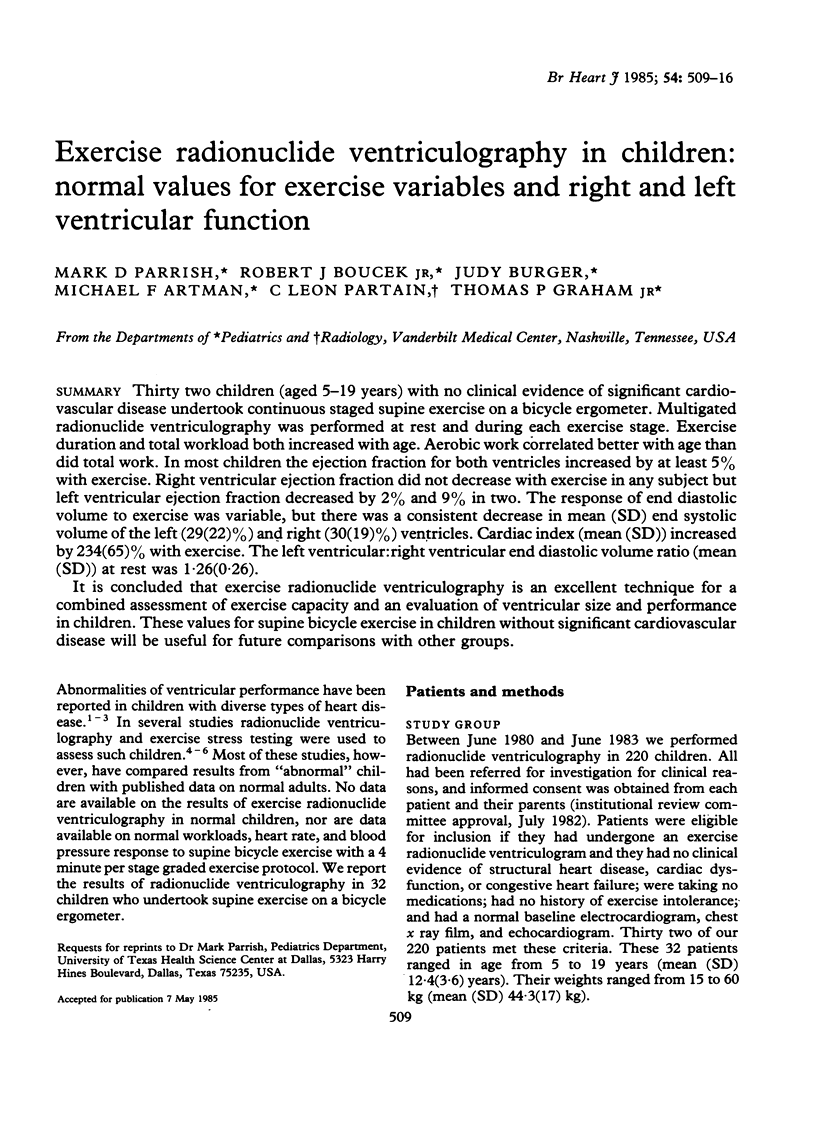
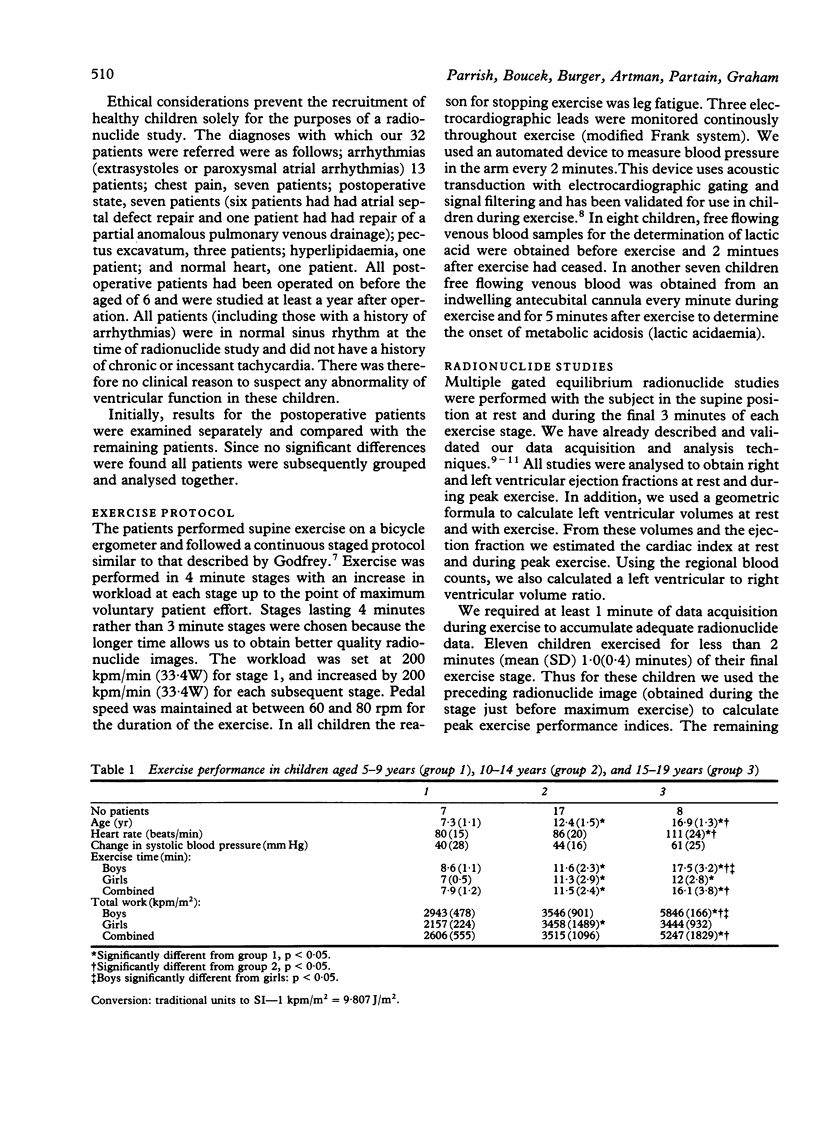

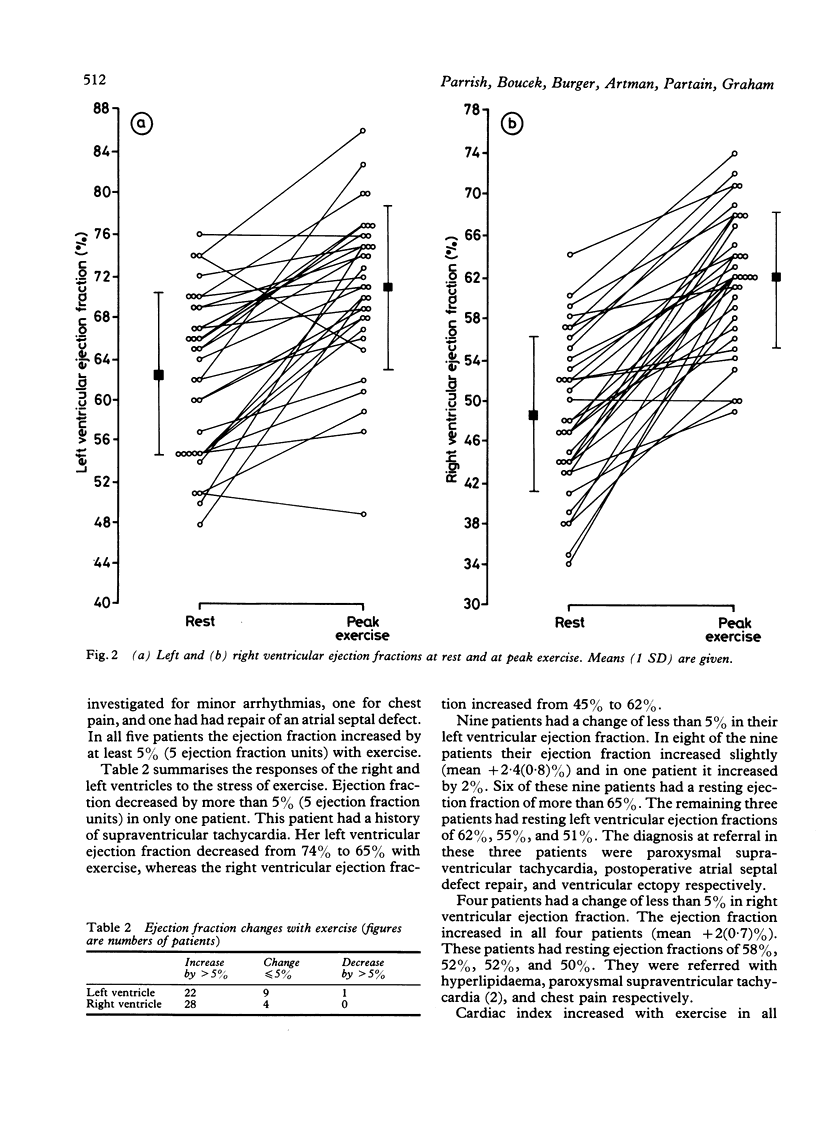
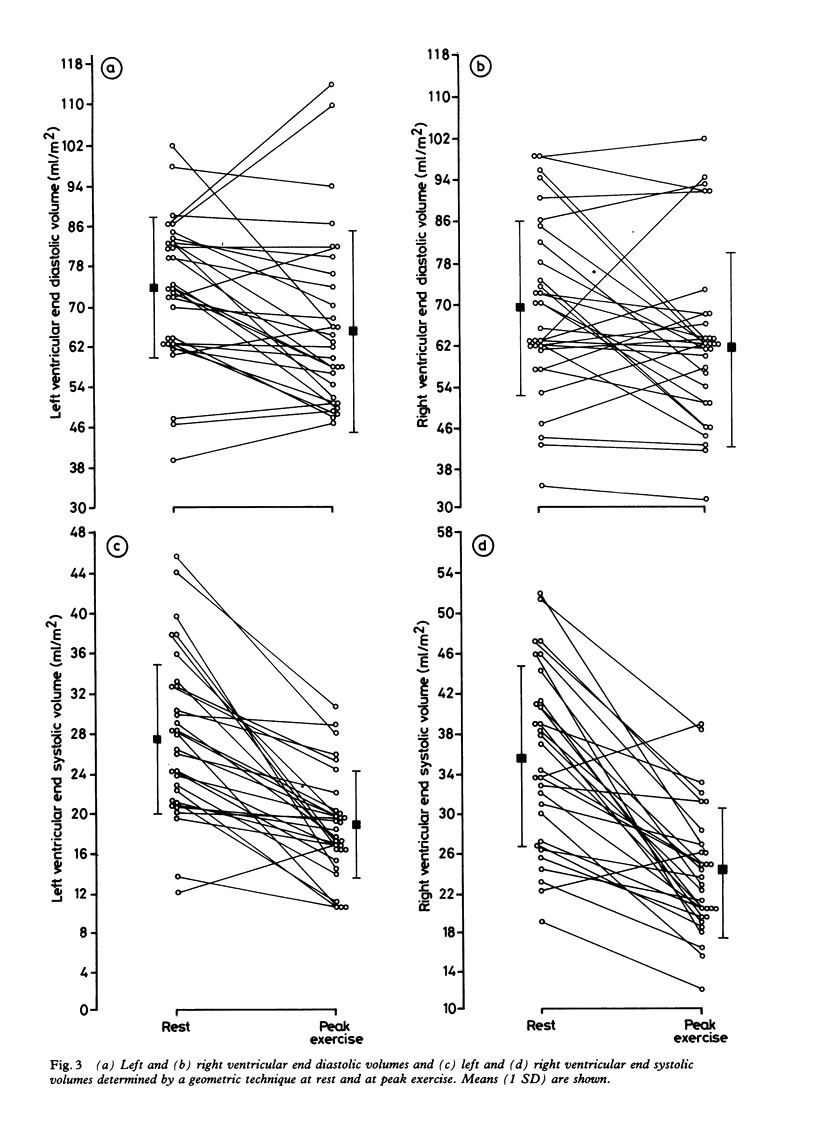
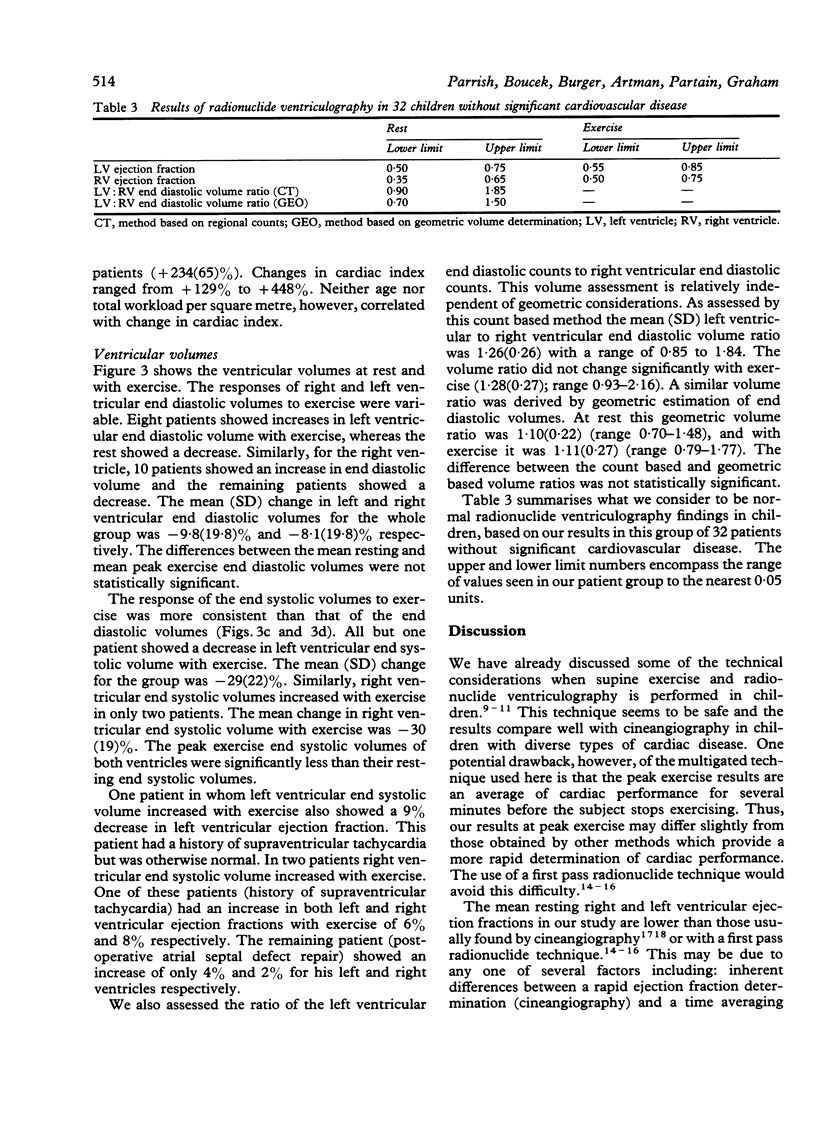
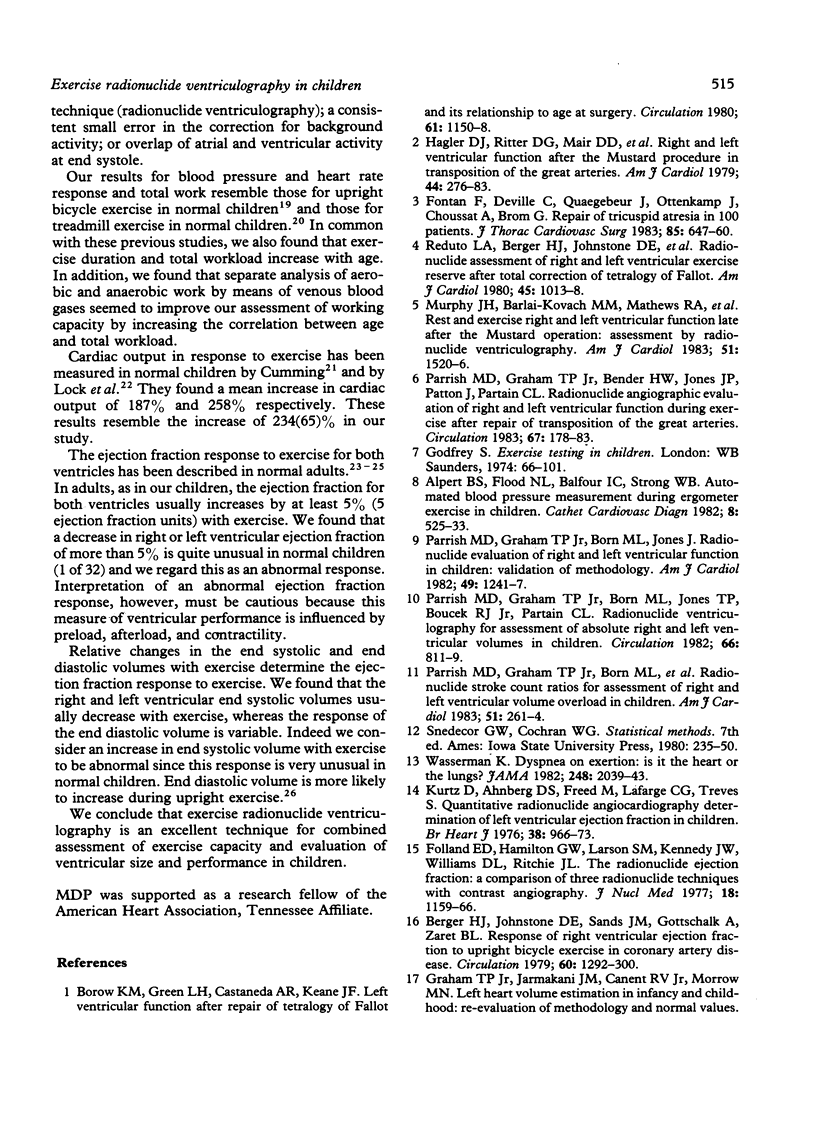
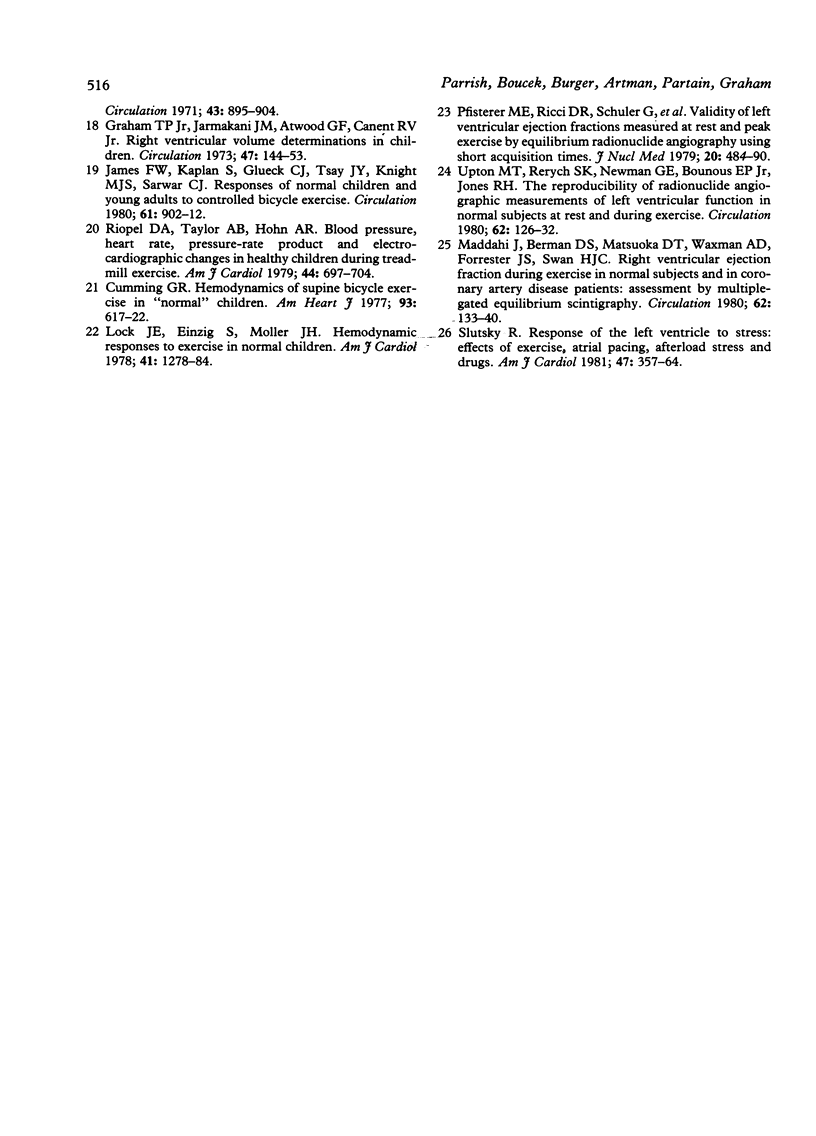
Selected References
These references are in PubMed. This may not be the complete list of references from this article.
- Alpert B. S., Flood N. L., Balfour I. C., Strong W. B. Automated blood pressure measurement during ergometer exercise in children. Cathet Cardiovasc Diagn. 1982;8(5):525–533. doi: 10.1002/ccd.1810080516. [DOI] [PubMed] [Google Scholar]
- Berger H. J., Johnstone D. E., Sands J. M., Gottschalk A., Zaret B. L. Response of right ventricular ejection fraction to upright bicycle exercise in coronary artery disease. Circulation. 1979 Dec;60(6):1292–1300. doi: 10.1161/01.cir.60.6.1292. [DOI] [PubMed] [Google Scholar]
- Borow K. M., Green L. H., Castaneda A. R., Keane J. F. Left ventricular function after repair of tetralogy of fallot and its relationship to age at surgery. Circulation. 1980 Jun;61(6):1150–1158. doi: 10.1161/01.cir.61.6.1150. [DOI] [PubMed] [Google Scholar]
- Cumming G. R. Hemodynamics of supine bicycle exercise in "normal" children. Am Heart J. 1977 May;93(5):617–622. doi: 10.1016/s0002-8703(77)80013-6. [DOI] [PubMed] [Google Scholar]
- Folland E. D., Hamilton G. W., Larson S. M., Kennedy J. W., Williams D. L., Ritchie J. L. The radionuclide ejection fraction: a comparison of three radionuclide techniques with contrast angiography. J Nucl Med. 1977 Dec;18(12):1159–1166. [PubMed] [Google Scholar]
- Fontan F., Deville C., Quaegebeur J., Ottenkamp J., Sourdille N., Choussat A., Brom G. A. Repair of tricuspid atresia in 100 patients. J Thorac Cardiovasc Surg. 1983 May;85(5):647–660. [PubMed] [Google Scholar]
- Graham T. P., Jr, Jarmakani J. M., Atwood G. F., Canent R. V., Jr Right ventricular volume determinations in children. Normal values and observations with volume or pressure overload. Circulation. 1973 Jan;47(1):144–153. doi: 10.1161/01.cir.47.1.144. [DOI] [PubMed] [Google Scholar]
- Hagler D. J., Ritter D. G., Mair D. D., Tajik A. J., Seward J. B., Fulton R. E., Ritman E. L. Right and left ventricular function after the Mustard procedure in transposition of the great arteries. Am J Cardiol. 1979 Aug;44(2):276–283. doi: 10.1016/0002-9149(79)90317-5. [DOI] [PubMed] [Google Scholar]
- Kurtz D., Ahnberg D. S., Freed M., LaFarge C. G., Treves S. Quantitative radionuclide angiocardiography. Determination of left ventricular ejection fraction in children. Br Heart J. 1976 Sep;38(9):966–973. doi: 10.1136/hrt.38.9.966. [DOI] [PMC free article] [PubMed] [Google Scholar]
- Lock J. E., Einzig S., Moller J. H. Hemodynamic responses to exercise in normal children. Am J Cardiol. 1978 Jun;41(7):1278–1284. doi: 10.1016/0002-9149(78)90886-x. [DOI] [PubMed] [Google Scholar]
- Maddahi J., Berman D. S., Matsuoka D. T., Waxman A. D., Forrester J. S., Swan H. J. Right ventricular ejection fraction during exercise in normal subjects and in coronary artery disease patients: assessment by multiple-gated equilibrium scintigraphy. Circulation. 1980 Jul;62(1):133–140. doi: 10.1161/01.cir.62.1.133. [DOI] [PubMed] [Google Scholar]
- Murphy J. H., Barlai-Kovach M. M., Mathews R. A., Beerman L. B., Park S. C., Neches W. H., Zuberbuhler J. R. Rest and exercise right and left ventricular function late after the Mustard operation: assessment by radionuclide ventriculography. Am J Cardiol. 1983 May 15;51(9):1520–1526. doi: 10.1016/0002-9149(83)90669-0. [DOI] [PubMed] [Google Scholar]
- Parrish M. D., Graham T. P., Jr, Bender H. W., Jones J. P., Patton J., Partain C. L. Radionuclide angiographic evaluation of right and left ventricular function during exercise after repair of transposition of the great arteries. Comparison with normal subjects and patients with congenitally corrected transposition. Circulation. 1983 Jan;67(1):178–183. doi: 10.1161/01.cir.67.1.178. [DOI] [PubMed] [Google Scholar]
- Parrish M. D., Graham T. P., Jr, Born M. L., Jones J. P., Boucek R. J., Jr, Artman M., Partain C. L. Radionuclide stroke count ratios for assessment of right and left ventricular volume overload in children. Am J Cardiol. 1983 Jan 15;51(2):261–264. doi: 10.1016/s0002-9149(83)80046-0. [DOI] [PubMed] [Google Scholar]
- Parrish M. D., Graham T. P., Jr, Born M. L., Jones J. P., Boucek R. J., Jr, Partain C. L. Radionuclide ventriculography for assessment of absolute right and left ventricular volumes in children. Circulation. 1982 Oct;66(4):811–819. doi: 10.1161/01.cir.66.4.811. [DOI] [PubMed] [Google Scholar]
- Parrish M. D., Graham T. P., Jr, Born M. L., Jones J. Radionuclide evaluation of right and left ventricular function in children: validation of methodology. Am J Cardiol. 1982 Apr 1;49(5):1241–1247. doi: 10.1016/0002-9149(82)90050-9. [DOI] [PubMed] [Google Scholar]
- Reduto L. A., Berger H. J., Johnstone D. E., Hellenbrand W., Wackers F. J., Whittemore R., Cohen L. S., Gottschalk A., Zaret B. L. Radionuclide assessment of right and left ventricular exercise reserve after total correction of tetralogy of Fallot. Am J Cardiol. 1980 May;45(5):1013–1018. doi: 10.1016/0002-9149(80)90170-8. [DOI] [PubMed] [Google Scholar]
- Riopel D. A., Taylor A. B., Hohn A. R. Blood pressure, heart rate, pressure-rate product and electrocardiographic changes in healthy children during treadmill exercise. Am J Cardiol. 1979 Oct;44(4):697–704. doi: 10.1016/0002-9149(79)90290-x. [DOI] [PubMed] [Google Scholar]
- Upton M. T., Rerych S. K., Newman G. E., Bounous E. P., Jr, Jones R. H. The reproducibility of radionuclide angiographic measurements of left ventricular function in normal subjects at rest and during exercise. Circulation. 1980 Jul;62(1):126–132. doi: 10.1161/01.cir.62.1.126. [DOI] [PubMed] [Google Scholar]
- Wasserman K. Dyspnea on exertion. Is it the heart or the lungs? JAMA. 1982 Oct 22;248(16):2039–2043. doi: 10.1001/jama.248.16.2039. [DOI] [PubMed] [Google Scholar]


